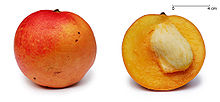Mangifera indica is a species of mango in the Anacardiaceae family. It is found in the wild in India and cultivated varieties have been introduced to other warm regions of the world.
The species appears to have been domesticated about 4,000 years ago.[citation needed] The species was brought to East Asia around 400-500 BCE from India; next, in the 15th century to the Philippines; and then, in the 16th century to Africa and Brazil by the Portuguese.[1] The species was described for science by Linnaeus in 1753.[2]
Mango is the national fruit of both India and Pakistan. It finds mention in the songs of 4th century CE Sanskrit poet, Kalidasa, prior to it is believed to have been tasted by Alexander (3rd century BCE) and Chinese pilgrim, Hieun Tsang (7th century CE). Later in 16th century Mughal Emperor, Akbar planted 100,000 mango trees in Darbhanga, Bihar at a place now known as Lakhi Bagh
National Fruit
Mangoes belong to the genus Mangifera, consisting of numerous species of tropical fruiting trees in the flowering plant family Anacardiaceae. The mango is indigenous to the Indian Subcontinent.[3] Cultivated in many tropical regions and distributed widely in the world, mango is one of the most extensively exploited fruits for food, juice, flavor, fragrance and color, making it a common ingredient in new functional foods often called superfruits. Its leaves are ritually used as floral decorations at weddings and religious ceremonies.



No comments:
Post a Comment